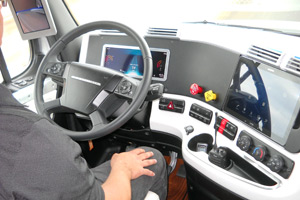Freightliner Touts Inspiration Truck as Aid to Drivers, Not Substitute for Them

 Jonathan S. Reiskin/Transport Topics
Jonathan S. Reiskin/Transport TopicsLAS VEGAS — Freightliner Trucks offered instruction to industry press with commercial driver licenses Sept. 15 on how to drive the autonomous Inspiration Truck that was unveiled in May.
Freightliner executives said Inspiration is not the result of customer feedback, but an attempt to show truck operators what advanced technology can do to improve highway safety. They also said a Level 3 autonomous vehicle such as Inspiration should be considered an aid to drivers and not a way to replace them.
PREVIOUS COVERAGE OF INSPIRATION TRUCK:
PHOTO GALLERY: Inspiration Truck | TT VIDEO: Daum exclusive interview| First drive | Crossing Hoover Dam | First close-up
FREIGHTLINER VIDEO: Scenes from Hoover Dam | Self-driving unveiling
MAKING IT LEGAL: Inspiration licensed for Nevada highways
“We’re really focused on safety with this, and I think that has been obscured by the ‘driverless’ factor that the mainstream press took,” said Diane Hames, a general manager for Freightliner’s parent company, Daimler Trucks North America.
Hames said a fully autonomous truck that needs no driver will probably not happen in her lifetime, but a truck that uses autonomous assistance for a driver, such as Inspiration, is much more realistic. She gave no date for commercial sales and said Inspiration should still be considered a concept vehicle rather than a prototype almost ready for the market.
Hames likened the autonomous truck to “bionics for drivers,” referring to two 1970s television programs, "The Six Million Dollar Man" and "The Bionic Woman."
“You start with the human eye, but they can see only so much. Then you add cameras and radar to that,” Hames said. Truck driving is not physically taxing in the way many construction and agricultural jobs are, but concentrating steadily for 11 hours a day is mentally fatiguing in the extreme.
 Jonathan S. Reiskin/Transport Topics
Jonathan S. Reiskin/Transport TopicsAutonomous assistance can reduce that fatigue by steering, braking and accelerating on interstates and other large highways.
Places where “you can get in a lane and go” is the ideal application for autonomous assistance, said Mary Aufdemberg, a DTNA marketing director.
Inspiration stays within a lane by viewing white or yellow highway lines — dashed or solid — with its two cameras. The system is programmed to know its limitations.
It yields control of the truck to the driver quickly if he or she either pumps the brakes or uses the steering wheel. If the system cannot find any highway lines, whether because of snow or faded paint, it tells the driver to take control, first with a visual statement and then with a sound alert. If the driver fails to do so, the system starts braking the truck to a stop.
Read more in the Sept. 21 issue of Transport Topics.

